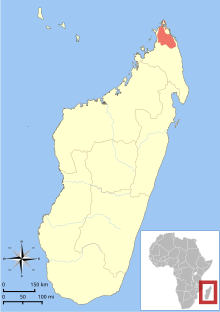Crowned lemur
| Crowned lemur | |
|---|---|

| |
| Male | |

| |
| Female both in Ankarana Reserve
| |
| Scientific classification | |
| Domain: | Eukaryota |
| Kingdom: | Animalia |
| Phylum: | Chordata |
| Class: | Mammalia |
| Order: | Primates |
| Suborder: | Strepsirrhini |
| Family: | Lemuridae |
| Genus: | Eulemur |
| Species: | E. coronatus
|
| Binomial name | |
| Eulemur coronatus (J. E. Gray, 1842)[3]
| |

| |
| Distribution of E. coronatus[1] | |
| Synonyms | |
| |
The crowned lemur (Eulemur coronatus) is a lemur that is 31–36 cm (12–14 in)[4] long and weighs 2 kg (4.4 lb). Its tail is about 42–51 cm (17–20 in) long.
Description
The crowned lemur is endemic to the dry deciduous
The crowned lemur is in the order of Primates as it possesses characteristics such as pseudo-opposable thumbs, binocular vision and is highly intelligent. E. coronatus shares with others of the family Lemuridae long and slender limbs, a slightly longer nose, a smaller brain and a 'grooming comb' formed by the incisors and canine teeth.
The crowned lemur possesses a long non-
This member of the genus Eulemur is primarily
-
Female
-
Female
-
Female
-
Juvenile male
Geographic range
Eulemur coronatus is thought to live exclusively in the northern region of Madagascar, ranging from the northernmost tip of the island, on the Cap d'Ambre Peninsula, extending south to the east bank of the Mahavavy River. Its range extends east, to the north of Sambava along the banks of the Manambato River.[10]
Habitat
E. coronatus can be found anywhere in the tropical dry forests of the
The crowned lemurs of Ankarana Reserve are the only lemurs in this region known to traverse the razor-sharp tsingy (the eroded limestone rock that is characteristic of this national park) as they head into the forest early in the morning and as they leave the forest just before sunset to settle in the safer canyon forest in the center of these rock fields for the night.
References
- ^ . Retrieved 19 November 2021.
- ^ "Checklist of CITES Species". CITES. UNEP-WCMC. Retrieved 18 March 2015.
- OCLC 62265494.
- ISBN 0-231-04704-5.
- ^ PMID 2807091.
- .
- ISBN 978-1-874687-48-1.
- ^ "BBC Nature - Crowned lemur videos, news and facts". Archived from the original on 27 March 2014. Retrieved 20 December 2019.
- ^ "DLC: Animals: Crowned Lemur". Archived from the original on 10 June 2010. Retrieved 11 July 2008.
- ^ ISBN 978-1-934151-23-5.





